CI6410 TB1: Analyzing Project Communication and Team Engagement
VerifiedAdded on 2022/09/27
|8
|1307
|35
Report
AI Summary
This report provides an in-depth analysis of project communication and team engagement strategies within the context of project actualization. It emphasizes the importance of communication methods such as face-to-face meetings, video conferencing, phone calls, and emails in ensuring that all project stakeholders understand their roles and responsibilities. The report highlights the benefits of effective communication, including improved team understanding, the ability to address challenges, and reduced project costs through minimized scope creep. It also details the roles of various stakeholders, including project managers, team members, project owners, and system users, and how their cooperation and engagement contribute to the overall success of a project. The report references a case study involving the redesign of a charity's website and the implementation of a new online system for streamlined communication and data management.

Room for work system design
Name
Institution
Professor
Course
Date
Name
Institution
Professor
Course
Date
Paraphrase This Document
Need a fresh take? Get an instant paraphrase of this document with our AI Paraphraser
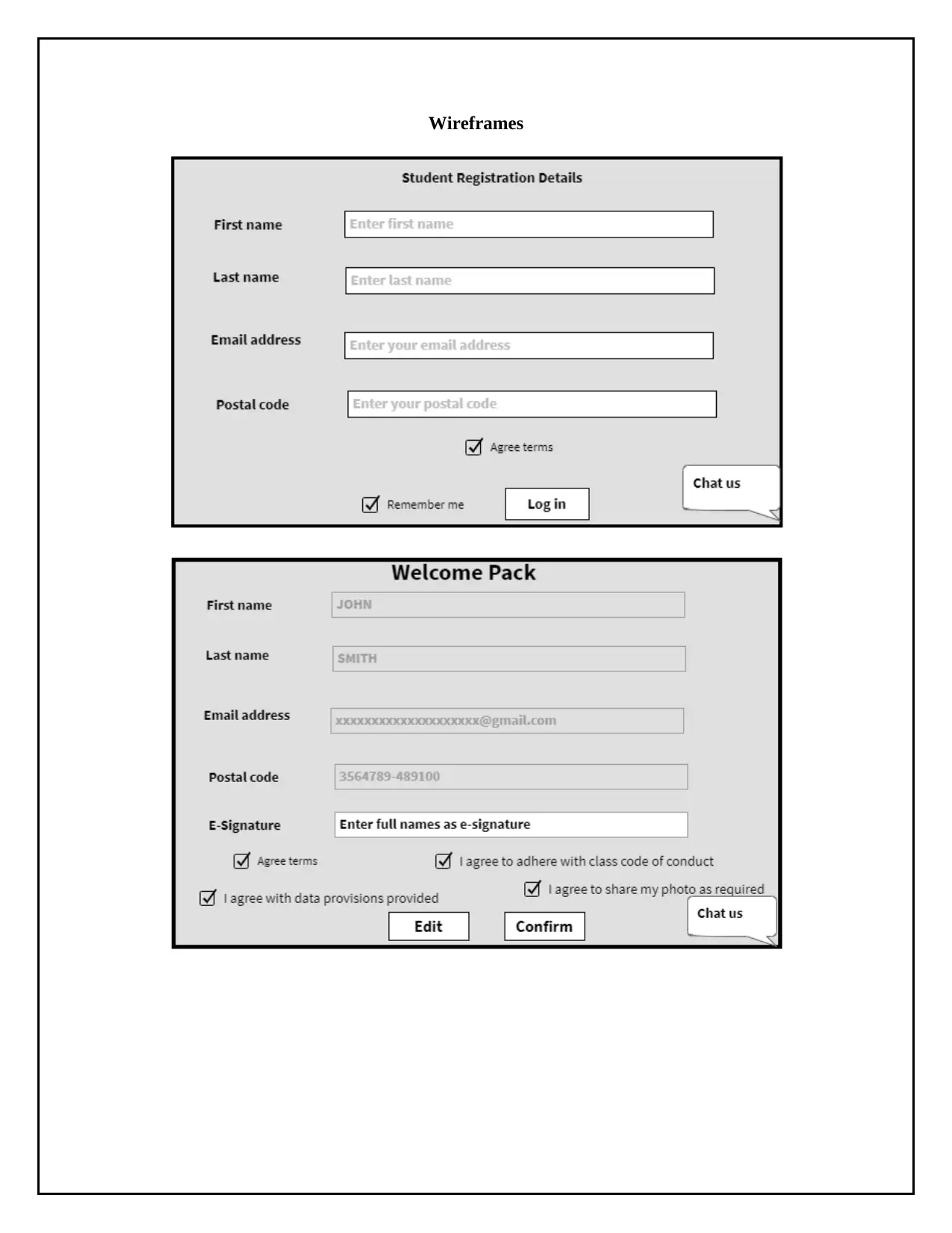
Wireframes
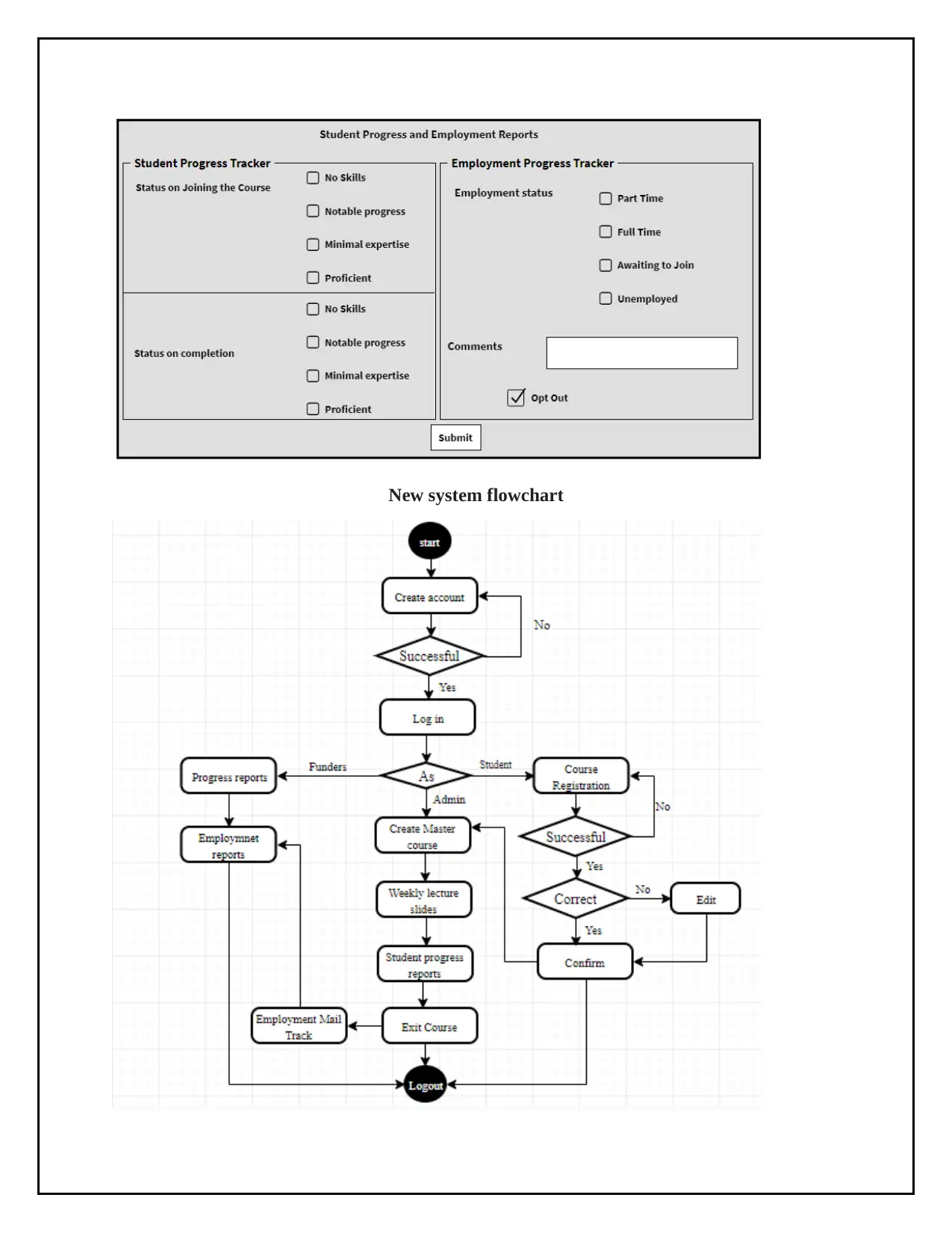
New system flowchart
⊘ This is a preview!⊘
Do you want full access?
Subscribe today to unlock all pages.

Trusted by 1+ million students worldwide
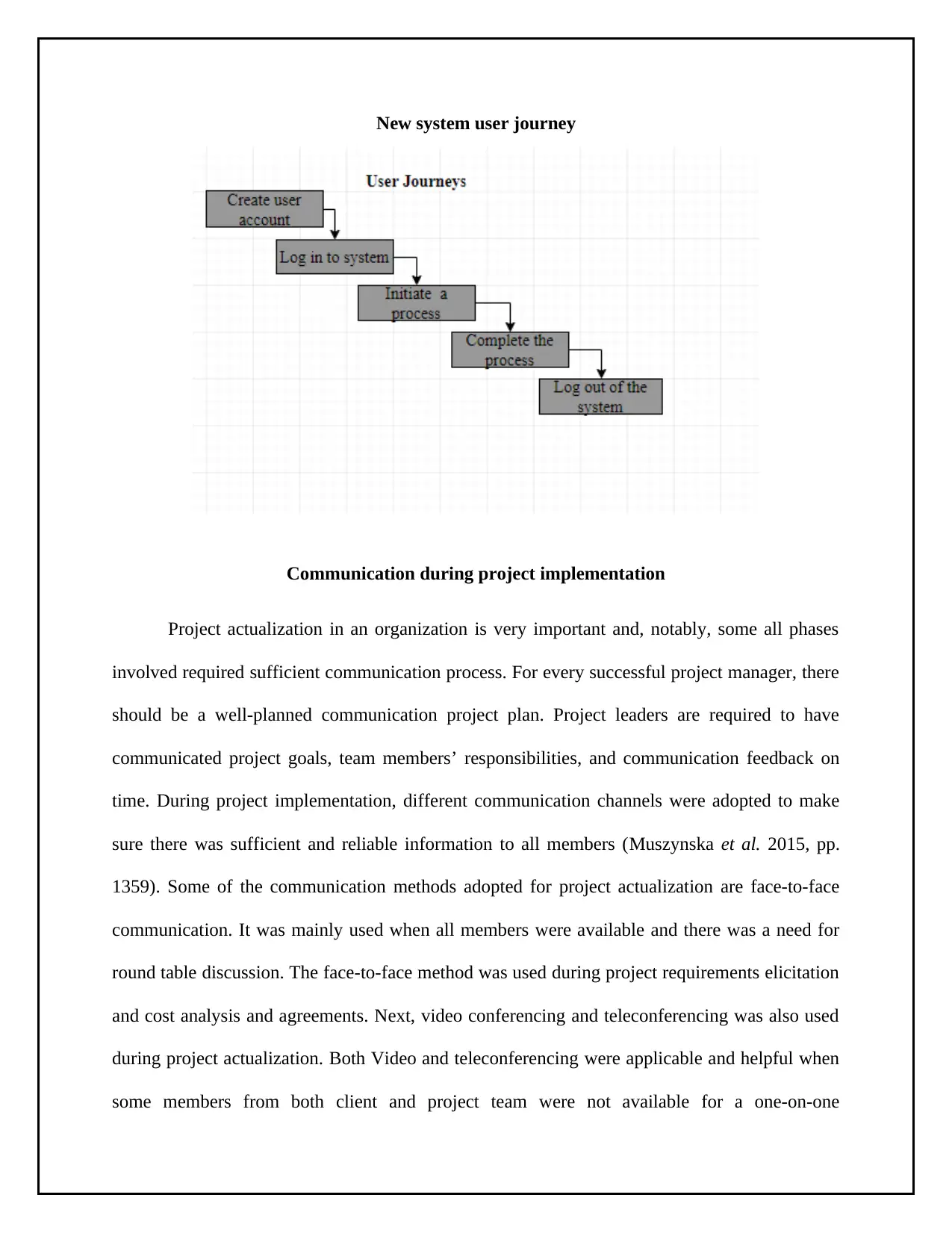
New system user journey
Communication during project implementation
Project actualization in an organization is very important and, notably, some all phases
involved required sufficient communication process. For every successful project manager, there
should be a well-planned communication project plan. Project leaders are required to have
communicated project goals, team members’ responsibilities, and communication feedback on
time. During project implementation, different communication channels were adopted to make
sure there was sufficient and reliable information to all members (Muszynska et al. 2015, pp.
1359). Some of the communication methods adopted for project actualization are face-to-face
communication. It was mainly used when all members were available and there was a need for
round table discussion. The face-to-face method was used during project requirements elicitation
and cost analysis and agreements. Next, video conferencing and teleconferencing was also used
during project actualization. Both Video and teleconferencing were applicable and helpful when
some members from both client and project team were not available for a one-on-one
Communication during project implementation
Project actualization in an organization is very important and, notably, some all phases
involved required sufficient communication process. For every successful project manager, there
should be a well-planned communication project plan. Project leaders are required to have
communicated project goals, team members’ responsibilities, and communication feedback on
time. During project implementation, different communication channels were adopted to make
sure there was sufficient and reliable information to all members (Muszynska et al. 2015, pp.
1359). Some of the communication methods adopted for project actualization are face-to-face
communication. It was mainly used when all members were available and there was a need for
round table discussion. The face-to-face method was used during project requirements elicitation
and cost analysis and agreements. Next, video conferencing and teleconferencing was also used
during project actualization. Both Video and teleconferencing were applicable and helpful when
some members from both client and project team were not available for a one-on-one
Paraphrase This Document
Need a fresh take? Get an instant paraphrase of this document with our AI Paraphraser
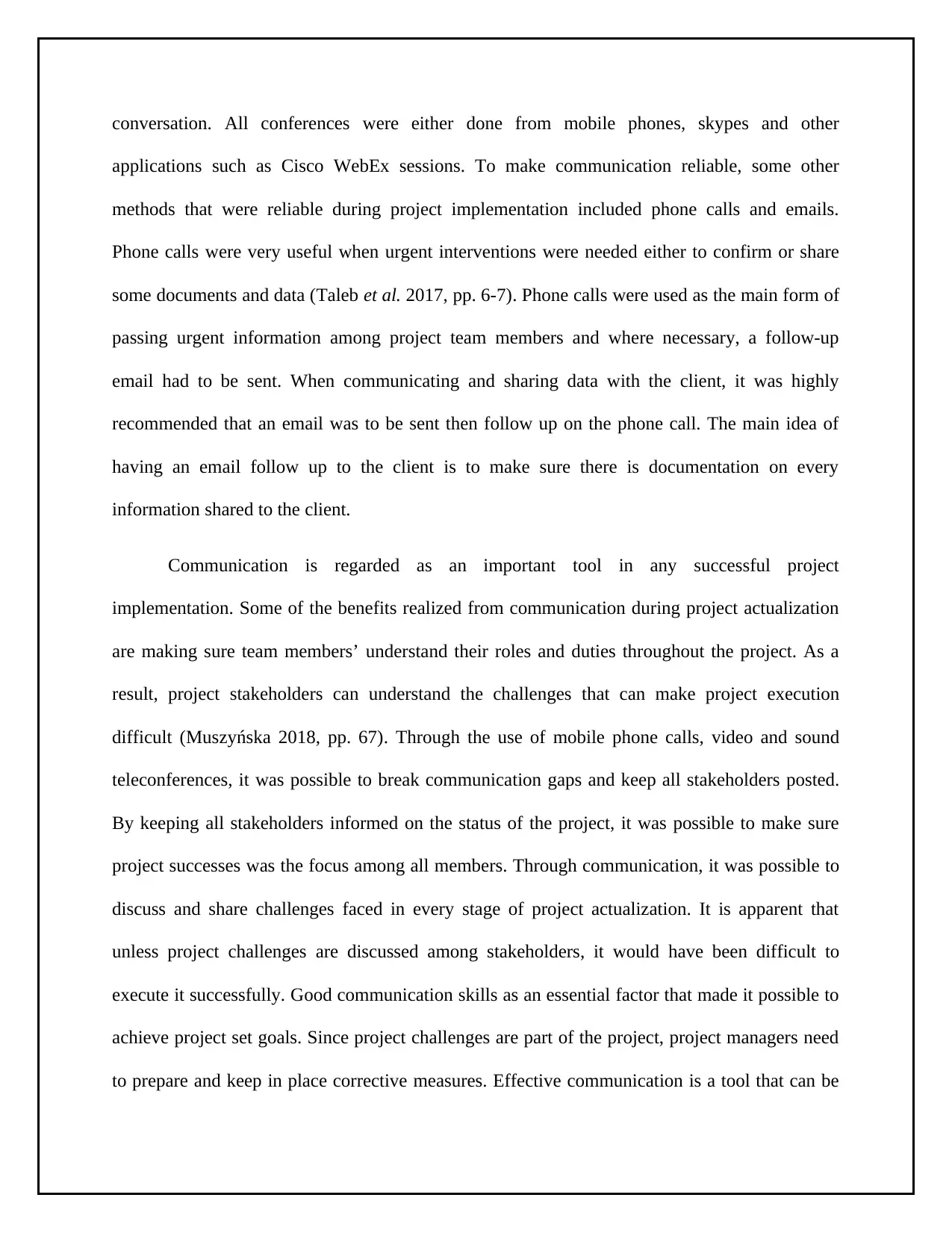
conversation. All conferences were either done from mobile phones, skypes and other
applications such as Cisco WebEx sessions. To make communication reliable, some other
methods that were reliable during project implementation included phone calls and emails.
Phone calls were very useful when urgent interventions were needed either to confirm or share
some documents and data (Taleb et al. 2017, pp. 6-7). Phone calls were used as the main form of
passing urgent information among project team members and where necessary, a follow-up
email had to be sent. When communicating and sharing data with the client, it was highly
recommended that an email was to be sent then follow up on the phone call. The main idea of
having an email follow up to the client is to make sure there is documentation on every
information shared to the client.
Communication is regarded as an important tool in any successful project
implementation. Some of the benefits realized from communication during project actualization
are making sure team members’ understand their roles and duties throughout the project. As a
result, project stakeholders can understand the challenges that can make project execution
difficult (Muszyńska 2018, pp. 67). Through the use of mobile phone calls, video and sound
teleconferences, it was possible to break communication gaps and keep all stakeholders posted.
By keeping all stakeholders informed on the status of the project, it was possible to make sure
project successes was the focus among all members. Through communication, it was possible to
discuss and share challenges faced in every stage of project actualization. It is apparent that
unless project challenges are discussed among stakeholders, it would have been difficult to
execute it successfully. Good communication skills as an essential factor that made it possible to
achieve project set goals. Since project challenges are part of the project, project managers need
to prepare and keep in place corrective measures. Effective communication is a tool that can be
applications such as Cisco WebEx sessions. To make communication reliable, some other
methods that were reliable during project implementation included phone calls and emails.
Phone calls were very useful when urgent interventions were needed either to confirm or share
some documents and data (Taleb et al. 2017, pp. 6-7). Phone calls were used as the main form of
passing urgent information among project team members and where necessary, a follow-up
email had to be sent. When communicating and sharing data with the client, it was highly
recommended that an email was to be sent then follow up on the phone call. The main idea of
having an email follow up to the client is to make sure there is documentation on every
information shared to the client.
Communication is regarded as an important tool in any successful project
implementation. Some of the benefits realized from communication during project actualization
are making sure team members’ understand their roles and duties throughout the project. As a
result, project stakeholders can understand the challenges that can make project execution
difficult (Muszyńska 2018, pp. 67). Through the use of mobile phone calls, video and sound
teleconferences, it was possible to break communication gaps and keep all stakeholders posted.
By keeping all stakeholders informed on the status of the project, it was possible to make sure
project successes was the focus among all members. Through communication, it was possible to
discuss and share challenges faced in every stage of project actualization. It is apparent that
unless project challenges are discussed among stakeholders, it would have been difficult to
execute it successfully. Good communication skills as an essential factor that made it possible to
achieve project set goals. Since project challenges are part of the project, project managers need
to prepare and keep in place corrective measures. Effective communication is a tool that can be
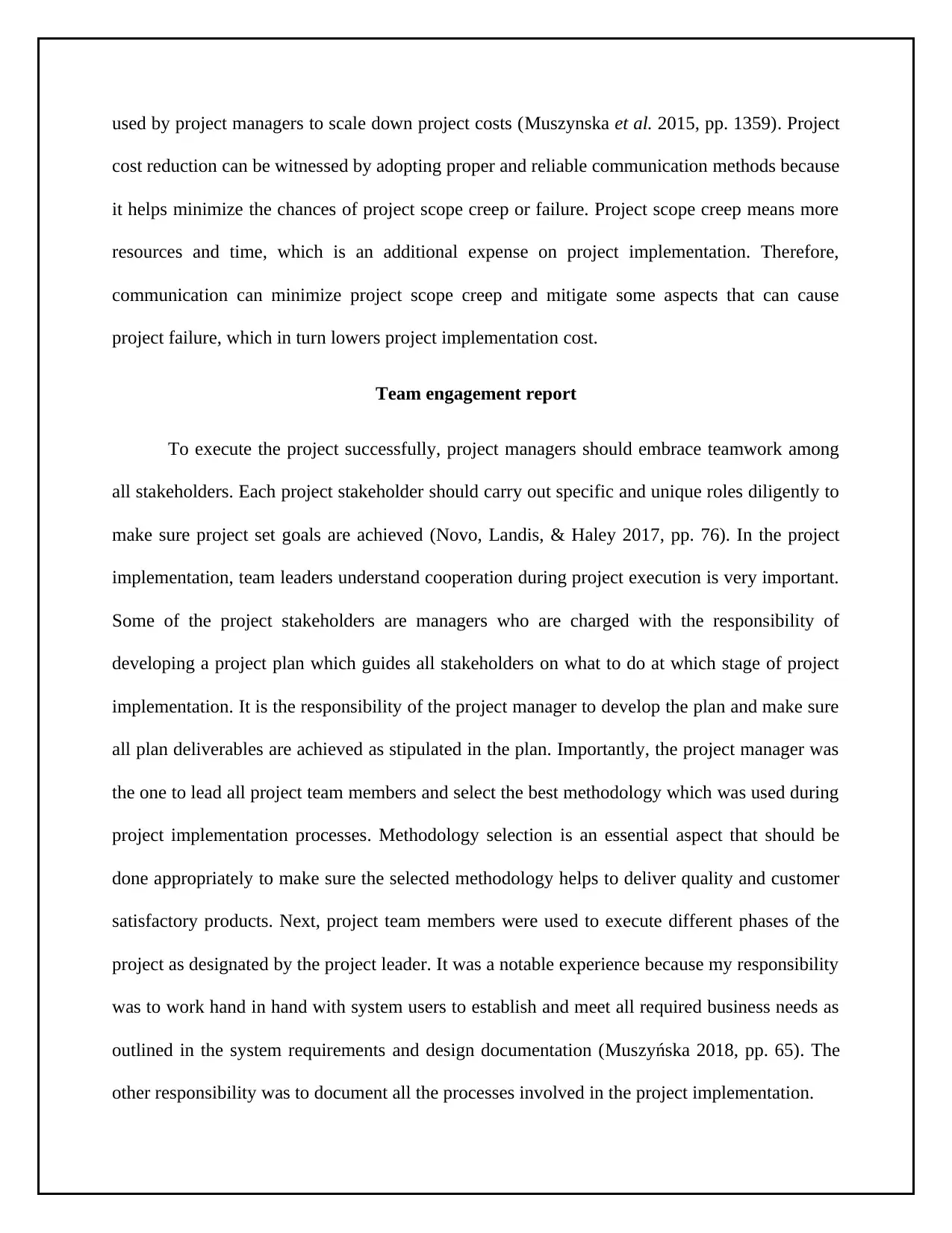
used by project managers to scale down project costs (Muszynska et al. 2015, pp. 1359). Project
cost reduction can be witnessed by adopting proper and reliable communication methods because
it helps minimize the chances of project scope creep or failure. Project scope creep means more
resources and time, which is an additional expense on project implementation. Therefore,
communication can minimize project scope creep and mitigate some aspects that can cause
project failure, which in turn lowers project implementation cost.
Team engagement report
To execute the project successfully, project managers should embrace teamwork among
all stakeholders. Each project stakeholder should carry out specific and unique roles diligently to
make sure project set goals are achieved (Novo, Landis, & Haley 2017, pp. 76). In the project
implementation, team leaders understand cooperation during project execution is very important.
Some of the project stakeholders are managers who are charged with the responsibility of
developing a project plan which guides all stakeholders on what to do at which stage of project
implementation. It is the responsibility of the project manager to develop the plan and make sure
all plan deliverables are achieved as stipulated in the plan. Importantly, the project manager was
the one to lead all project team members and select the best methodology which was used during
project implementation processes. Methodology selection is an essential aspect that should be
done appropriately to make sure the selected methodology helps to deliver quality and customer
satisfactory products. Next, project team members were used to execute different phases of the
project as designated by the project leader. It was a notable experience because my responsibility
was to work hand in hand with system users to establish and meet all required business needs as
outlined in the system requirements and design documentation (Muszyńska 2018, pp. 65). The
other responsibility was to document all the processes involved in the project implementation.
cost reduction can be witnessed by adopting proper and reliable communication methods because
it helps minimize the chances of project scope creep or failure. Project scope creep means more
resources and time, which is an additional expense on project implementation. Therefore,
communication can minimize project scope creep and mitigate some aspects that can cause
project failure, which in turn lowers project implementation cost.
Team engagement report
To execute the project successfully, project managers should embrace teamwork among
all stakeholders. Each project stakeholder should carry out specific and unique roles diligently to
make sure project set goals are achieved (Novo, Landis, & Haley 2017, pp. 76). In the project
implementation, team leaders understand cooperation during project execution is very important.
Some of the project stakeholders are managers who are charged with the responsibility of
developing a project plan which guides all stakeholders on what to do at which stage of project
implementation. It is the responsibility of the project manager to develop the plan and make sure
all plan deliverables are achieved as stipulated in the plan. Importantly, the project manager was
the one to lead all project team members and select the best methodology which was used during
project implementation processes. Methodology selection is an essential aspect that should be
done appropriately to make sure the selected methodology helps to deliver quality and customer
satisfactory products. Next, project team members were used to execute different phases of the
project as designated by the project leader. It was a notable experience because my responsibility
was to work hand in hand with system users to establish and meet all required business needs as
outlined in the system requirements and design documentation (Muszyńska 2018, pp. 65). The
other responsibility was to document all the processes involved in the project implementation.
⊘ This is a preview!⊘
Do you want full access?
Subscribe today to unlock all pages.

Trusted by 1+ million students worldwide
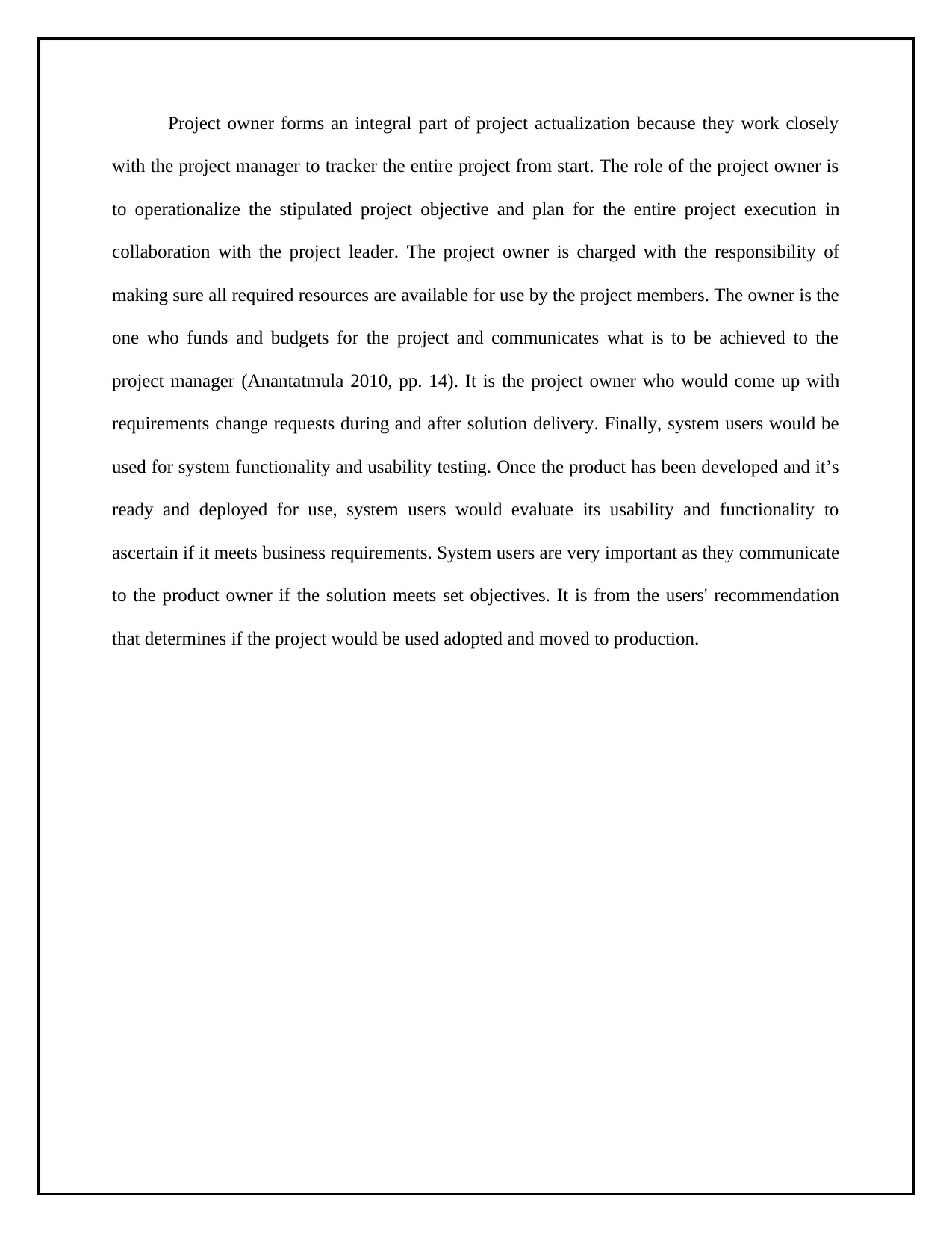
Project owner forms an integral part of project actualization because they work closely
with the project manager to tracker the entire project from start. The role of the project owner is
to operationalize the stipulated project objective and plan for the entire project execution in
collaboration with the project leader. The project owner is charged with the responsibility of
making sure all required resources are available for use by the project members. The owner is the
one who funds and budgets for the project and communicates what is to be achieved to the
project manager (Anantatmula 2010, pp. 14). It is the project owner who would come up with
requirements change requests during and after solution delivery. Finally, system users would be
used for system functionality and usability testing. Once the product has been developed and it’s
ready and deployed for use, system users would evaluate its usability and functionality to
ascertain if it meets business requirements. System users are very important as they communicate
to the product owner if the solution meets set objectives. It is from the users' recommendation
that determines if the project would be used adopted and moved to production.
with the project manager to tracker the entire project from start. The role of the project owner is
to operationalize the stipulated project objective and plan for the entire project execution in
collaboration with the project leader. The project owner is charged with the responsibility of
making sure all required resources are available for use by the project members. The owner is the
one who funds and budgets for the project and communicates what is to be achieved to the
project manager (Anantatmula 2010, pp. 14). It is the project owner who would come up with
requirements change requests during and after solution delivery. Finally, system users would be
used for system functionality and usability testing. Once the product has been developed and it’s
ready and deployed for use, system users would evaluate its usability and functionality to
ascertain if it meets business requirements. System users are very important as they communicate
to the product owner if the solution meets set objectives. It is from the users' recommendation
that determines if the project would be used adopted and moved to production.
Paraphrase This Document
Need a fresh take? Get an instant paraphrase of this document with our AI Paraphraser
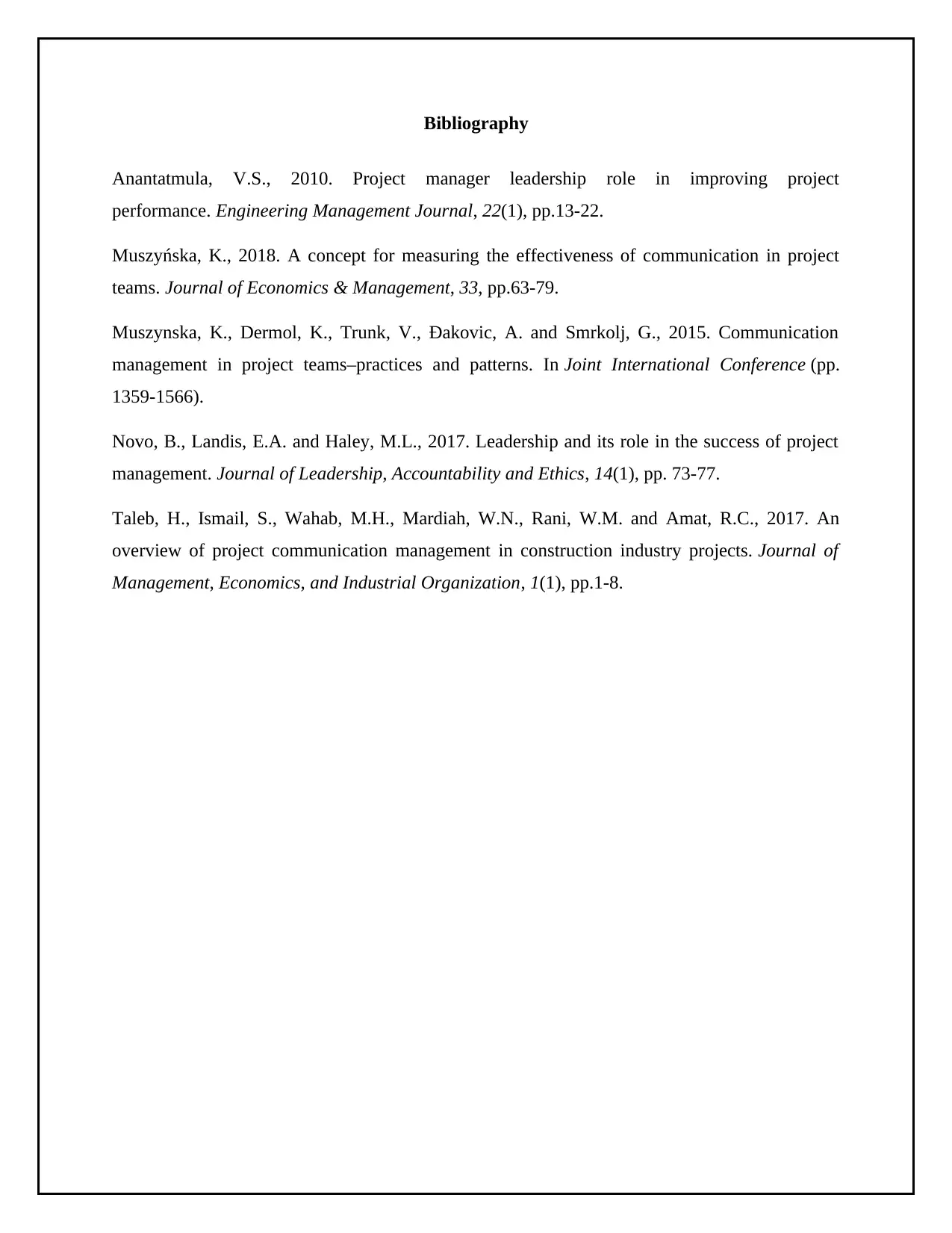
Bibliography
Anantatmula, V.S., 2010. Project manager leadership role in improving project
performance. Engineering Management Journal, 22(1), pp.13-22.
Muszyńska, K., 2018. A concept for measuring the effectiveness of communication in project
teams. Journal of Economics & Management, 33, pp.63-79.
Muszynska, K., Dermol, K., Trunk, V., Ðakovic, A. and Smrkolj, G., 2015. Communication
management in project teams–practices and patterns. In Joint International Conference (pp.
1359-1566).
Novo, B., Landis, E.A. and Haley, M.L., 2017. Leadership and its role in the success of project
management. Journal of Leadership, Accountability and Ethics, 14(1), pp. 73-77.
Taleb, H., Ismail, S., Wahab, M.H., Mardiah, W.N., Rani, W.M. and Amat, R.C., 2017. An
overview of project communication management in construction industry projects. Journal of
Management, Economics, and Industrial Organization, 1(1), pp.1-8.
Anantatmula, V.S., 2010. Project manager leadership role in improving project
performance. Engineering Management Journal, 22(1), pp.13-22.
Muszyńska, K., 2018. A concept for measuring the effectiveness of communication in project
teams. Journal of Economics & Management, 33, pp.63-79.
Muszynska, K., Dermol, K., Trunk, V., Ðakovic, A. and Smrkolj, G., 2015. Communication
management in project teams–practices and patterns. In Joint International Conference (pp.
1359-1566).
Novo, B., Landis, E.A. and Haley, M.L., 2017. Leadership and its role in the success of project
management. Journal of Leadership, Accountability and Ethics, 14(1), pp. 73-77.
Taleb, H., Ismail, S., Wahab, M.H., Mardiah, W.N., Rani, W.M. and Amat, R.C., 2017. An
overview of project communication management in construction industry projects. Journal of
Management, Economics, and Industrial Organization, 1(1), pp.1-8.
1 out of 8
Related Documents
Your All-in-One AI-Powered Toolkit for Academic Success.
+13062052269
info@desklib.com
Available 24*7 on WhatsApp / Email
![[object Object]](/_next/static/media/star-bottom.7253800d.svg)
Unlock your academic potential
Copyright © 2020–2025 A2Z Services. All Rights Reserved. Developed and managed by ZUCOL.


